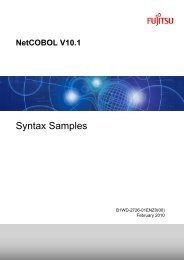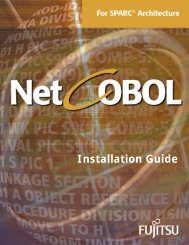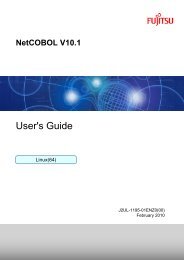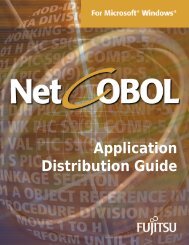NetCOBOL for SPARC Architecture SAF Subroutines User's Guide
NetCOBOL for SPARC Architecture SAF Subroutines User's Guide
NetCOBOL for SPARC Architecture SAF Subroutines User's Guide
Create successful ePaper yourself
Turn your PDF publications into a flip-book with our unique Google optimized e-Paper software.
Executing a Web Application<br />
Chapter 4. Generating and Executing a Web Application 77<br />
Place the MIME extension used by the Web applicationin the ACTION attribute of the<br />
FORM tag in the Web page that invokes the application as follows:<br />
<br />
<br />
sample <br />
<br />
<br />
:<br />
<br />
<br />
<br />
Allocate this Web page (HTML document) in an appropriate document directory of<br />
NES and start the application by using it.<br />
Note: Web applications may be frequently modified during testing. In operation<br />
environment, however, NES keeps the first copy of the application that it loads in<br />
memory, so that NES must be stopped and restarted to load the modified version. It<br />
is possible to stop and restart the NES from the NES administration screen.<br />
<strong>SAF</strong> Director Reference<br />
COBOL_Init<br />
Specify the Web application to be loaded by NES and the environment setup file <strong>for</strong><br />
the application.<br />
Format:<br />
Init fn="COBOL_Init"<br />
[load="DLL name1, entry-name 11 [, entry-name 12]…[;DLL name 2, entry-name<br />
21 [, entry-name 22]…]…"]<br />
[env="environment setup file"] [sev="log output severity of <strong>SAF</strong> director"]<br />
Parameters:<br />
• load<br />
Target DLL names <strong>for</strong> loading and entry-names scheduled <strong>for</strong> execution are<br />
listed. Use an absolute path <strong>for</strong> the .DLL name. Use commas <strong>for</strong> delimiting<br />
entry-names belonging to the .DLL. Specify at least one entry-name <strong>for</strong> a .DLL.<br />
To specify multiple .DLL names, use a semi-colon.<br />
•<br />
env<br />
Specify an absolute path <strong>for</strong> an environment setup file. In the environment<br />
setup file, specify variables as follows:<br />
SET environment variable name = environment variable value<br />
Given below is an example of environment setup file description when the Web<br />
application is stored in "C:\COBAP."







